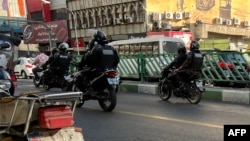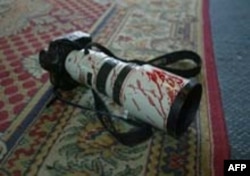Rights groups have accused Iran's security forces of launching "an all-out military attack" on protesters in Kurdish areas in the western part of the country as anger intensifies over the death of 22-year-old Mahsa Amini while in police custody last month.
Iran has been rocked by the unrest that was sparked by Amini's death on September 16 while she was being detained for allegedly wearing a hijab improperly. Protesters have challenged the authorities, who have responded with heavy-handed tactics that rights groups say have left almost 200 dead, many from the Kurdish part of the country where Amini came from.
Some videos posted on social media of protests in the Kurdish city of Sanandaj showed security agents shooting directly at protesters on October 10, the same day Amnesty International warned about a crackdown by "security forces using firearms and firing tear gas indiscriminately, including into people’s homes."
Added another rights group, the Hengaw Human Rights Organization: "Sanandaj has been under an all-out military attack by the Islamic Republic of Iran. At the same time, access routes, including the Internet, have been cut off, the access to immediate treatment of the wounded is under pressure from the security agents, and documents received by Hengaw show the use of prohibited war weapons."
WATCH: More than 1,000 Iranian oil workers have joined in nationwide protests over the death of 22-year-old Mahsa Amini.
Hengaw also reported that it had received information that government forces stationed in the western cities of Saghez and Divandareh also had weaponry such as machine guns.
Videos posted on social media from the southern Iranian city of Marvdasht showed protesters tearing down pictures of Qasem Soleimani, the former commander of the Quds Force, who was killed by the United States in a drone attack in Iraq in 2020.
The protests over Amini's death came after a summer of unrest across Iran over poor living conditions, water shortages, and economic difficulties resulting from crippling sanctions the United States has imposed on Iran over its nuclear program.
Iran's oil industry, one of the few sectors of the economy able to bring in money for the government, has joined in the demonstrations, with videos on October 10 showing striking workers burning tires and blocking roads outside the Asalouyeh petrochemical plant in the southwest.
WATCH: The mother of Nika Shakarami -- a 16-year-old who wound up dead after participating in anti-government protests in Tehran on September 20 -- has accused the Iranian authorities of "lying" about her daughter's death in an attempt to "exempt themselves."
The demonstrators could be heard shouting slogans including "Death to the dictator" and "Don't be scared. We are all together!"
More than 1,000 workers at the Bushehr, Damavand, and Hengam petrochemical companies also went on strike, while those at the Abadan oil refinery and Kangan Petro Refining Company joined in on October 11.
The Organizing Council of Oil Contract Workers in Iran said that a number of protesters were arrested during a strike by Bushehr petrochemical workers in the southern Iranian city of Asaluyeh on October 10.
Written by Ardeshir Tayebi based on an original story in Persian by RFE/RL's Radio Farda



